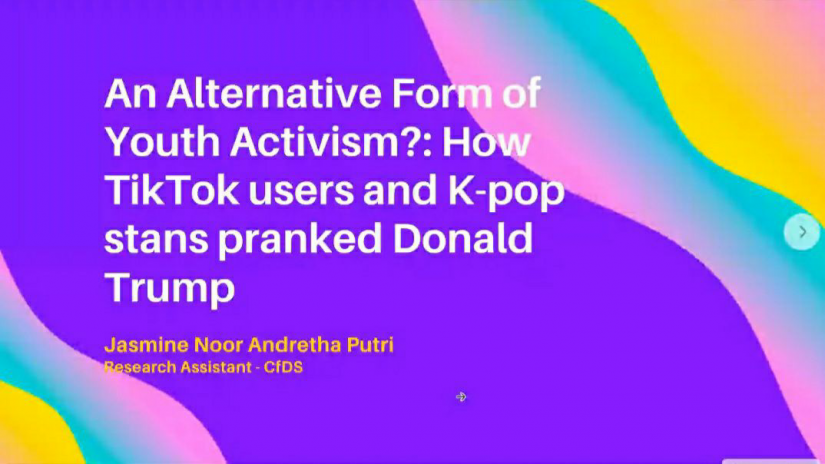
Before talking about the topics in details, Jasmine began her explanation with the general description of the youth activism in the digital era. The prank against Donald Trump case happened at the same time with Donald Trump’s first campaign after his temporary hiatus because of COVID-19. The reservation of this campaign had reached one million tickets. But, on the D-day, just 6.200 people came to the campaign location. The big gap was due to many ‘fake reservations’ invitation.
Started from TikTok, especially the Alt TikTok sub-genre, this invitations were shared on the Twitter and caused the increasing amount of the mass. The mass movement in the social media also happened with the Black Lives Matter campaign by the K-Popers. They spammed videos on the hashtag which against the Black Lives Matter, temporarily damaged the Dallas Police’s application because of those spammed videos, and fundraised for the BLM campaign that reached millions of dollars.
Jasmine explained, both of those cases shown the increasing of social media usage as the alternative of social activism. Other than that, both of those cases also indicated that political change could be pushed through socio-cultural mechanism, not only by the conventional political institution. The conventional political institution that were complicated and slow in adjusting with the new changes made the usage of social media as the change tool. But, it did not mean that this phenomenon removed all the conventional political participation, it just became the diversification of political expression methods which was used by the youths.
A little bit different than Jasmine, Ines explained more about the injustice language that killed social justice on the internet. As she began her explanation, Ines invited the audience to play a simple game. Ines gave several characteristics which referred to the SJW (Social Justice Warrior) stereotypes in society. SJW was a derogatory term for the people who had the social progressive perspective, such as feminism, civil rights, and multiculturalism.
Ines then talked about the history of the changing meaning of SJW term, from the neutral and tended to be positive, to negative. The SJW term appeared for the first time on the 1991, when Montreal Gazette defined an activist in Canada. The derogatory usage of SJW term first happened in 2014, when the #GamerGate scandal happened. This scandal suffered heavy casualties, from the death threat to the rape, to the spread of the victim’s privacy data.
The term SJW then used by the perpetrators to the people who defended the victim. They thought that well-being issues must not be brought to the common platforms. The changing meaning of this SJW term then brought the injustice language up, they were the terms that muted the important social issues which need to be talked. Ines also gave several examples about what could we do to response this phenomenon, such as stop using the injustice language and start voicing the justice.
Both Jasmine and Ines closed their explanation with a quote. While explaining the topics, both of them did not forget to attached the uploads from social media as the examples for the audience to make them understand more about the context of the topics. The discussion was continued with question and answer session that opened in three sessions, with total of eight questions. After taking a group photo, both of the speakers gave their closing statements.
“The injustice language has many forms, even the things that we did not realize. Let’s become more aware, do our opinions muted other people opinions? If it’s a yes, it’s better not to upload it,” Ines advised. Jasmine added, “We, as the youths, have the voices which can be used to the changes for better future. Use the social media to voice it.”
“Justice must be enforced, and justice is the only choice,” Fajar said as he closed the discussion at 05.31 p.m. For those who could not join this discussion, you could watch the Difussion #28 on the CfDS YouTube channel.
